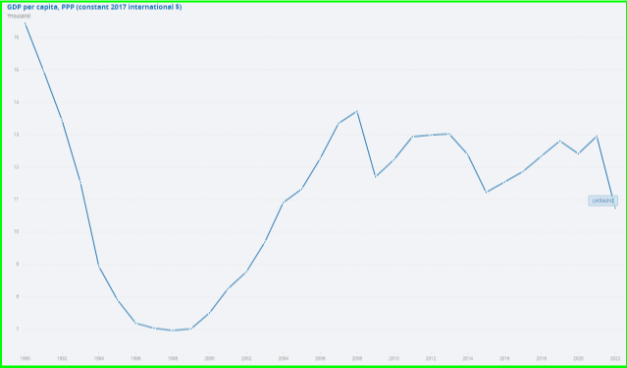Western media coverage of the Russia–Ukraine war has shifted remarkably in recent weeks. Previously, with a few exceptions, reportage and commentary relied closely on official Ukrainian sources. As a result, these reports were marked by a relentless optimism. Now a more realistic view has begun to take hold, driven by several factors: the failure of Ukraine’s 2023 summer offensive; constant, incremental Russian gains in the time since; and the ongoing doubt over continued US aid.
With all these developments, onlookers are now considering the possibility of a long-term stalemate. Many sources last year conceded that this was more probable than an outright Ukrainian victory.
Speculating further, we may begin to consider not only a stalemate but a general collapse of the Ukrainian line. Although the fortunes of war are always murky, we must consider the trajectories the nation may take if that collapse occurs. What outcomes could we see for Ukraine?
The scenario of little change
One plausible scenario, there would be very little change.
As I noted in a previous article, Russia already controls enough Ukrainian territory to achieve most of the key objectives that drove it to war. Russian forces need relatively limited advances to occupy the remainder of the Ukrainian territories of Donetsk and Luhansk, which would fulfill Russia’s promises to its allies in the Donbas region. Russian control of the Kherson region has already allowed it to break Ukraine’s blockade of Crimea, addressing the economic and water supply issues which that blockade presented.
Even if Russia interpreted its annexation decree as requiring the full occupation of the Kherson and Zaporizhzhia, as well as Donetsk and Luhansk, the new conquest would be limited. Russia simply has no need to occupy vast tracts of Ukraine to fulfill its war aims.
Of course, even if such an occupation would be superfluous, Russia’s goals could grow more ambitious as its situation improves. Russia could be tempted to snatch unneeded gains as their costs plummet. However, two factors combat the potential for an increased Russian appetite: the threat of Western confrontation and Ukrainian insurgency.
First, the West’s reaction remains an unpredictable variable. Quick, massive Russian gains could renew Western investment in the war. It could even lead NATO to deploy in Ukraine. Indeed, French President Emmanuel Macron left the possibility open in comments last Monday. His NATO allies, however, do not appear to be as keen.
Although direct NATO involvement seems far-fetched, note that the West, especially the United States, has already crossed several of Russia’s red lines in support of Ukraine. Though deployments near the front line are unlikely, NATO forces could very well deploy in cities like Odesa or Kyiv, limiting any increase in Russia’s appetite. Putin has a history of caution concerning potential Western confrontations, so it is highly unlikely that Russia would risk direct combat with Western forces in such a scenario.
Second, anti-Russian Ukrainian nationalism is prevalent in western Ukraine. The further one travels west, the stronger it becomes. Thus far in the war, Russia has managed to avoid difficulties with insurgency, administering its conquered territories at relatively low cost. This would probably cease if Russia took significantly more land. The gargantuan extent of such conquest and the more hostile population in these regions would render Ukrainian resistance more difficult and expensive to suppress. Given that public support in Russia for such ambitious war goals is already waning, extensive territorial conquests would be a political albatross around the administration’s neck, not a desirable asset.
The scenario of a delegitimized Ukraine
However, in another plausible scenatio, a Ukrainian military collapse would be catastrophic for the nation’s integrity. Failure to stand up against Russia would compromise the legitimacy of the Ukrainian state, since the current regime derives its legitimacy from the nationalist appeal of its resistance to Russia. It has little else to stand on, given its failure to deliver in any other respect.
The Revolution of Dignity, also known as the Maidan Revolution, has been an unmitigated disaster for Ukraine’s economy. The disorder resulting from the political turmoil has created a steep economic decline. This gradually and painfully reversed between 2015 and 2021, when gross domestic product (GDP) per capita nearly recovered to 2013 levels — until Russia’s invasion in February 2022 caused economic collapse
Even with economic and military aid from the US, EU, World Bank, International Monetary Fund (IMF) and other donors, the invasion’s impact was severe. Ukraine’s GDP per capita is currently lower than it has been since 2003. Meanwhile, the poverty level has skyrocketed.

Ukrainian endurance has been conditioned by unrealistic but ingrained expectations that a comprehensive victory over Russia would yield other amazing perks. The people desire sustained Western aid, quick integration into the EU and rapid advances that would quickly restore Ukraine’s economy to its former level and well beyond. A military collapse would definitively prove that no such revival is coming. Additionally, it would demonstrate the nation’s lack of utility as a proxy to use against Russia, which would dampen Western motivation to support Ukraine.
In such a scenario, Ukraine’s population would have only one remaining hope: the possibility of a slight and gradual alleviation of its misery, devoid of the pride that comes from resisting a powerful opponent. How can any government, especially the notoriously corrupt one ruling Ukraine, maintain legitimacy then?
Such a scenario could see the West intervene. Such intervention would not aim to repel Russia, but rather shore up the failing Ukrainian state on the EU’s eastern border.
[Lee Thompson-Kolar edited this piece.]
The views expressed in this article are the author’s own and do not necessarily reflect Fair Observer’s editorial policy.
Support Fair Observer
We rely on your support for our independence, diversity and quality.
For more than 10 years, Fair Observer has been free, fair and independent. No billionaire owns us, no advertisers control us. We are a reader-supported nonprofit. Unlike many other publications, we keep our content free for readers regardless of where they live or whether they can afford to pay. We have no paywalls and no ads.
In the post-truth era of fake news, echo chambers and filter bubbles, we publish a plurality of perspectives from around the world. Anyone can publish with us, but everyone goes through a rigorous editorial process. So, you get fact-checked, well-reasoned content instead of noise.
We publish 2,500+ voices from 90+ countries. We also conduct education and training programs
on subjects ranging from digital media and journalism to writing and critical thinking. This
doesn’t come cheap. Servers, editors, trainers and web developers cost
money.
Please consider supporting us on a regular basis as a recurring donor or a
sustaining member.
Will you support FO’s journalism?
We rely on your support for our independence, diversity and quality.










Comment